 |
This is a small family from East Africa and Madagascar, then India through
South-East Asia to northern Australia and the islands of the Western Pacific.
Three species of Sonneratia (the only genus in the family here)
are found in mangrove communities around the northern coastline of Australia.
Characteristic features of the family Sonneratiaceae in Australia include:
- trees in mangrove forests, without buttresses but with pneumatophores
(breathing roots)
- leaves opposite
- flowers large, pomegranate-like, with many conspicous stamens
- sepals 4–8, prominent, leathery; petals 4–8, narrow, often
falling early or absent
- ovary superior or half-inferior, developing into a fleshy berry
Description
Evergreen mangrove trees, or rarely shrubs. Internal secretions not obvious. Plants glabrous. Leaves opposite, petiolate. Stipules apparently absent, or present and distinct and free from the petiole, gland-like, persistent or apparently falling off early. Lamina simple, symmetric, lanceolate, ovate, elliptic, oblanceolate, obovate or orbicular; base cuneate or attenuate; margins entire, ±flat; venation pinnate, with the midrib conspicuous, and the tertiary venation reticulate; surfaces not punctate; herbaceous or leathery. All the flowers bisexual. Inflorescences terminal, consisting of cymes or solitary flowers. Bracts and bracteoles absent. Pollination by insects, birds or bats. Flowers fragrant or malodorous, stalked. Floral disc present. Free hypanthium present. Perianth regular, of 2 dissimilar whorls. Calyx segments free, with 4–8 sepals, valvate in bud; leathery. Corolla segments free, with 4–8 petals (rarely absent), alternating with the sepals, crumpled or plicate in bud, white, red, pink or green, without contrasting markings, or streaked, spotted, etc, membranous; claws absent; lobes ±entire. Fertile stamens numerous, not clearly correlated with the sepals, free of the corolla, free of the ovary and style, distinct from each other, all ±equal. Anthers dorsifixed, versatile, opening by longitudinal slits, 2-celled. Ovary superior and sessile, or part-inferior. Carpels 12–20, fused; ovary with 12–20 locules. Style terminal, single and unbranched with the stigma capitate. Ovules numerous per locule, sessile; placentation axile. Fruit a fleshy indehiscent berry; the perianth on the maturing fruit deciduous, or dry and persistent. Disseminule macro-surface featureless; micro-surface ±smooth, brown, dull. Seeds numerous per fruit. Aril absent. Cotyledons 2. Embryo straight or curved.
(Note: this description has been generated from the coded data compiled for the key. Any errors in the key data will be reflected in the descriptions.)
A treatment of the family Sonneratiaceae has been published in:
Flora of Australia 18: 87-91.
Australian genera of Sonneratiaceae (as recognised for the Flora of Australia)
Sonneratia

|
  |

Sonneratia caseolaris (flowers and fruit)
Photo: M.Fagg © M.Fagg
|
 |
|